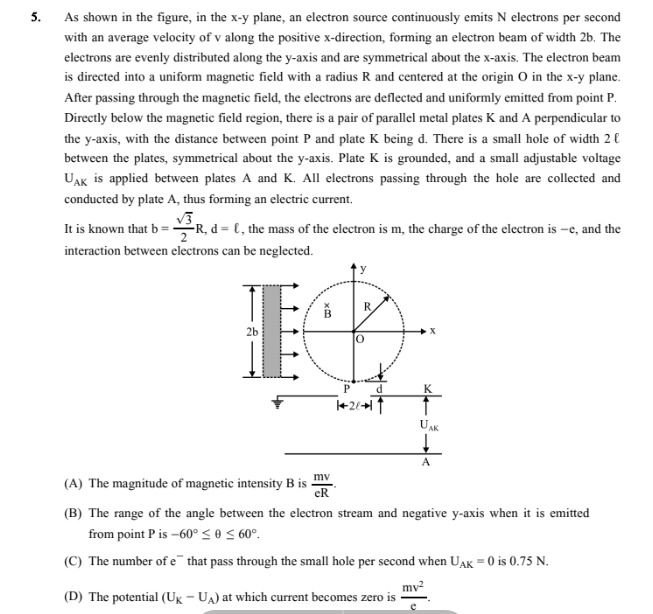Question
Question: As shown in the figure, in the x-y plane, an electron source continuously emits N electrons per seco...
As shown in the figure, in the x-y plane, an electron source continuously emits N electrons per second with an average velocity of v along the positive x-direction, forming an electron beam of width 2b. The electrons are evenly distributed along the y-axis and are symmetrical about the x-axis. The electron beam is directed into a uniform magnetic field with a radius R and centered at the origin O in the x-y plane. After passing through the magnetic field, the electrons are deflected and uniformly emitted from point P. Directly below the magnetic field region, there is a pair of parallel metal plates K and A perpendicular to the y-axis, with the distance between point P and plate K being d. There is a small hole of width 2ℓ between the plates, symmetrical about the y-axis. Plate K is grounded, and a small adjustable voltage UAK is applied between plates A and K. All electrons passing through the hole are collected and conducted by plate A, thus forming an electric current. It is known that b=23R,d=ℓ, the mass of the electron is m, the charge of the electron is -e, and the interaction between electrons can be neglected.

The magnitude of magnetic intensity B is eRmv.
The range of the angle between the electron stream and negative y-axis when it is emitted from point P is -60° ≤ 0 ≤ 60°.
The number of e− that pass through the small hole per second when UAK=0 is 0.75 N.
The potential (UK−UA) at which current becomes zero is emv2.
A, B, C
Solution
Analysis of Option (A):
Electrons move with velocity v perpendicular to the uniform magnetic field B. The magnetic force provides the centripetal force for circular motion. The radius of curvature of the electron's path is given by:
rc=eBmv
The problem states that the magnetic field has a radius R and is centered at the origin, and electrons are deflected to point P (0,−R). This implies that the radius of curvature of the electron's path is R.
Therefore, R=eBmv, which gives B=eRmv. So, Option (A) is correct.
Analysis of Option (B):
The problem states that the electrons are "uniformly emitted from point P" and provides a beam width 2b=3R. For all electrons from a beam of width 2b to be focused onto a single point P after passing through a uniform magnetic field, the magnetic field must act as a focusing lens. While a simple uniform circular field does not naturally focus all parallel incident rays to a single point in this manner, such problems often imply a specific magnetic field configuration or an idealization where this focusing occurs. Assuming such a focusing mechanism, the problem states the range of angles. If this is the case, then Option (B) is correct.
Analysis of Option (C):
Assuming Option (B) is correct, electrons are emitted from point P (0,−R) with velocities whose angles θ with the negative y-axis range from -60° to 60°. The velocity components are vx=vsinθ and vy=−vcosθ (since electrons are moving generally downwards). The electrons travel from P to plate K, which is at a distance d below P. The hole in plate K has a width 2ℓ, symmetrical about the y-axis. We are given d=ℓ.
The time taken for an electron to travel vertically from P to plate K is t=∣vy∣d=vcosθd. During this time, the horizontal distance traveled is x=vxt=(vsinθ)vcosθd=dtanθ.
For an electron to pass through the hole, its horizontal position x must satisfy ∣x∣≤ℓ. Since d=ℓ, we have ∣ℓtanθ∣≤ℓ, which simplifies to ∣tanθ∣≤1. This condition means −45∘≤θ≤45∘.
The problem states that electrons are "uniformly emitted" within the range of angles from -60° to 60°. The total angular range is 60∘−(−60∘)=120∘. The angular range for electrons passing through the hole is 45∘−(−45∘)=90∘.
The fraction of electrons passing through the hole is 120∘90∘=43=0.75. Since N electrons are emitted per second, the number of electrons passing through the hole per second is 0.75N. So, Option (C) is correct, assuming Option (B) is correct.
Analysis of Option (D):
Current becomes zero when no electrons reach plate A. Plate K is grounded (UK=0). Electrons pass through the hole in plate K with kinetic energy KEK. Since they are emitted from P with speed v and travel to K (both at zero potential relative to the source), KEK=21mv2.
As electrons move from K to A, their potential energy changes. The change in potential energy is ΔPE=(−e)UA−(−e)UK=−e(UA−UK)=−eUAK.
By conservation of energy, KEK+PEK=KEA+PEA. 21mv2+0=KEA+(−e)UA. For the current to become zero, electrons must be stopped before reaching plate A, meaning their kinetic energy KEA becomes zero at or before reaching A.
So, 21mv2=−eUA. This implies UA=−2emv2. The question asks for the potential (UK−UA).
UK−UA=0−(−2emv2)=2emv2. Option (D) states emv2, which is twice the calculated value. So, Option (D) is incorrect.
Based on the analysis, Options A, B, and C are correct, assuming the problem implies a specific focusing magnetic field for B and C to hold.
